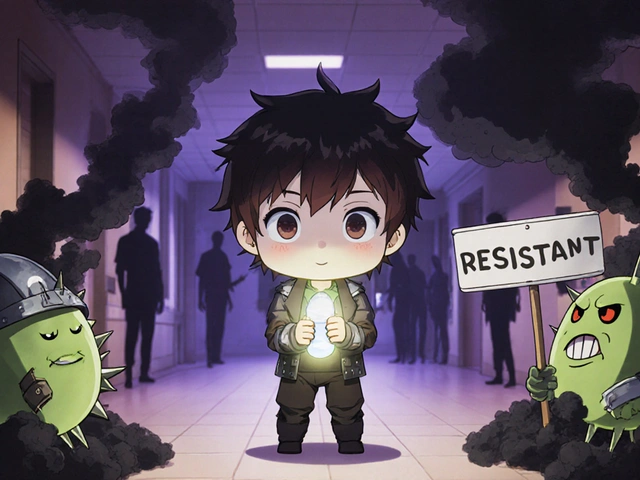TL;DR
- Steroids can trigger a fast, sometimes severe eye pressure rise. Brinzolamide cuts aqueous production and lowers IOP by ~15-20% as monotherapy; another ~10-15% as add‑on.
- Use it when you can’t stop steroids, or when prostaglandins are risky (active inflammation, cystoid macular oedema, herpetic keratitis risk, early post‑op).
- Dose 1 drop 3×/day (some do 2×/day once stable). Simbrinza (brinzolamide + brimonidine) is a strong combo when you need more pressure drop without prostaglandins.
- Watch for taste changes, blurred vision on instillation, and avoid in severe renal impairment or compromised corneal endothelium. Shake the suspension well.
- Recheck pressure in 2-4 weeks. If IOP stays high or optic nerve is at risk, add another class, short course oral acetazolamide, laser, or surgical options.
Steroid drops, injections, and implants save sight-but they can also jack up eye pressure and damage the optic nerve if you miss the spike. The question isn’t just “does brinzolamide work?” It’s when to choose it, how to dose it in real life, and what to pair it with when prostaglandins aren’t your friend. This guide gives you tight, practical steps from mechanism to monitoring, with UK‑relevant tips you can use today.
Why brinzolamide fits steroid‑induced glaucoma-and when to pick it
Steroid‑induced glaucoma is a pressure problem caused by steroids making the trabecular meshwork stiffer and more crowded. The outflow jams, pressure rises, and in some people it rises hard and fast-within weeks of topical steroids, and often within days after intravitreal implants (dexamethasone, fluocinolone) or periocular injections. The job is simple: reduce aqueous production now, protect the optic nerve, and taper or switch the steroid if the eye can tolerate it.
Brinzolamide is a topical carbonic anhydrase inhibitor (CAI). By blocking carbonic anhydrase in the ciliary processes, it slows bicarbonate formation, reduces aqueous humour secretion, and lowers intraocular pressure (IOP). As a single agent it lowers IOP ~15-20%; added to a prostaglandin, beta‑blocker, or alpha‑agonist, you usually see another ~10-15% dip. Its main rival is dorzolamide. Both work about the same, but brinzolamide is a suspension and tends to sting less; the flip side is brief blur after each drop because it’s a milky suspension (shake well).
In steroid‑induced scenarios, brinzolamide earns its keep because you often want to avoid prostaglandins. Why? Prostaglandins can nudge inflammation, worsen or trigger cystoid macular oedema, and reactivate herpetic keratitis-exactly the patients who get steroids. So your first move is usually an aqueous suppressant (CAI, beta‑blocker) ± alpha‑agonist, not a prostaglandin. This is reflected in major guidance (NICE NG81, 2022; AAO Preferred Practice Pattern, 2024; European Glaucoma Society Guidelines, 2020/2024 update).
When is brinzolamide a particularly good pick?
- You can’t stop the steroid: uveitis flares without it; post‑op inflammation still hot; a macular oedema implant is in situ.
- Prostaglandins are off the table: recent intraocular surgery, active uveitis, CME risk, herpetic history.
- You need additive lowering without systemic beta‑blocker issues: asthma, COPD, bradycardia, heart block.
- Comfort matters: dorzolamide stings more in many patients; brinzolamide is often better tolerated.
When to pause and rethink? Avoid brinzolamide in severe renal impairment (eGFR/CrCl <30 mL/min) and in corneas with weak endothelium (Fuchs’ dystrophy, prior endothelial keratoplasty), where topical CAIs can push a borderline cornea into oedema. Treat “sulfa allergy” with nuance: while brinzolamide is a sulfonamide derivative, true cross‑reactivity from non‑antibiotic sulfonamides is uncommon; still, counsel and monitor if history is severe (UK SmPC: Azopt, 2024).
How fast and how much? Onset starts within hours, with near‑steady effect in 1-2 weeks. Typical IOP drop depends on baseline pressure, steroid load, and whether it’s a solo agent or add‑on. In eyes spiking after intravitreal steroid, pairing brinzolamide with brimonidine (Simbrinza) often brings a 25-30% cut without touching prostaglandins. If you need more, a beta‑blocker (timolol) is a clean add except in airway/cardiac disease.
Dosing that works: 1 drop in the affected eye(s) three times daily. Once stable, many clinicians try twice‑daily maintenance, but if pressure creeps up, go back to three times daily. Space it 5-10 minutes from other drops. Contact lenses out before instillation and back in after 15 minutes; the preservative (often benzalkonium chloride) binds to soft lenses and can irritate.
Real‑world combos you’ll lean on:
- Brinzolamide + brimonidine (fixed combo: Simbrinza) when prostaglandins are risky.
- Brinzolamide + timolol when you can use a beta‑blocker and want strong suppression with just 2 bottles.
- Triple: brinzolamide + brimonidine + timolol for big spikes after steroid implants (consider oral acetazolamide for a few days if the optic nerve looks threatened).
Evidence signposts you can trust: NICE NG81 (2022) recommends starting with agents that fit the eye’s context; in inflamed or post‑op eyes, aqueous suppressants are preferred. The AAO PPP (2024) and EGS Guidelines (2020/2024) echo that CAIs are effective as mono‑ or add‑on therapy, with prostaglandins used more cautiously around active inflammation. The UK SmPC for brinzolamide (Azopt, 2024) sets dosing, contraindications, and key cautions noted above.
| Therapy | Typical IOP reduction | Onset | Dosing (UK) | Notes for steroid‑induced cases |
|---|---|---|---|---|
| Brinzolamide 1% (CAI) | ~15-20% mono; +10-15% add‑on | Hours; near‑steady in 1-2 weeks | 1 drop TID (BID once stable in some) | Good when prostaglandins avoided; shake; brief blur; avoid in eGFR <30, weak corneal endothelium |
| Brimonidine 0.2% (alpha‑2) | ~20-25% early; wanes in some | Hours | BID-TID | Useful add‑on; fatigue, dry mouth; rare allergy over time |
| Timolol 0.25-0.5% (beta‑blocker) | ~20-30% | Hours | BID (some QD) | Avoid in asthma/COPD/bradycardia/heart block; strong add‑on |
| Simbrinza (brinzolamide + brimonidine) | ~25-30% (combo) | Hours | TID | Handy when avoiding prostaglandins; one bottle, two mechanisms |
| Prostaglandin analogues | ~25-33% | Days; steady by 2-4 weeks | QD (night) | Avoid/limit in active inflammation, CME risk, early post‑op, herpetic keratitis history |
| Oral acetazolamide (CAI) | Rapid, large drop | Hours | 250 mg BID-QID (short course) | Short‑term bridge for big spikes; watch electrolytes, fatigue, GI |
Bottom line: if a steroid is raising IOP and you want a comfortable, prostaglandin‑sparing option, brinzolamide is usually near the front of the queue.

How to use brinzolamide step by step (with or without steroid taper)
Here’s a clean, practical workflow you can apply in clinic or share with patients so everyone knows the plan.
- Confirm the steroid link: Ask what steroid, route (drop, injection, implant, systemic), dose, and start date. Inhalers and skin creams around the eyes count too. Spikes often appear within 2-6 weeks of topical steroids and within days to weeks after implants.
- Risk‑stratify the optic nerve: Look at nerve head, RNFL/OCT, and fields (or at least confrontations if time is short). The higher the baseline risk or damage, the lower your target IOP and the faster you act.
- Adjust the steroid if safe: If the eye allows, taper potency or switch to a “softer” steroid (loteprednol, fluorometholone) or add a non‑steroidal anti‑inflammatory under the treating surgeon’s plan. If inflammation is still active, don’t under‑treat it; protect pressure instead.
- Start brinzolamide: 1 drop in the affected eye(s) three times a day. Shake the bottle for 10 seconds before each dose. Press gently on the inner corner (punctal occlusion) for 1-2 minutes to limit systemic absorption and bitter taste.
- Layer sensibly: If you need more drop, choose based on the eye and the person: brimonidine if you want a prostaglandin‑free combo; timolol if no airway/cardiac issues; or use the fixed combo Simbrinza to keep bottles down. Avoid prostaglandins in active inflammation/CME risk unless the benefit clearly outweighs the risk.
- Space the drops: Leave 5-10 minutes between different eye drops so the second one doesn’t wash the first away. Ointments last.
- Contact lenses: Take lenses out before drops, put them back after 15 minutes. Preservatives can soak into soft lenses and irritate.
- Review on time: Recheck IOP in 2-4 weeks; sooner (7-10 days) if the spike is big (>30 mmHg) or the nerve is vulnerable. If IOP is still high, add a class or move to oral acetazolamide for a short bridge while you organise next steps.
- Escalate when needed: If pressure is uncontrolled or the optic nerve worsens, consider laser (SLT) if the angle is open and the eye is quiet enough, or surgery/MIGS if steroid exposure is ongoing. People with steroid implants often need surgical options.
- Educate fast, keep it simple: Teach drop technique (don’t touch the eye, one drop is enough, close lids, press inner corner), common side effects, and when to call if vision fogs, the cornea looks hazy, or pain spikes.
Quick decision rules you’ll actually use:
- Steroid still essential + inflamed eye? Start brinzolamide now; add brimonidine or timolol if target isn’t met. Leave prostaglandins for later.
- Post‑cataract CME risk? Prefer CAI + alpha‑agonist or beta‑blocker early; delay prostaglandins until the macula is safe.
- Big spike after dexamethasone implant? Go robust: Simbrinza ± timolol, and consider a short course oral acetazolamide. Set the expectation that surgery may be needed if the implant is repeated.
- Asthma/COPD, bradycardia, AV block? Skip timolol. Use CAI + alpha‑agonist instead.
- eGFR <30, Fuchs’ dystrophy, or prior endothelial keratoplasty? Avoid topical CAIs if possible; consider other classes and non‑med options sooner.
Monitoring cadence (UK‑friendly):
- New start or change: IOP check in 2-4 weeks (earlier for big spikes).
- Stable: every 3-6 months depending on risk. Add OCT/fields as indicated.
- Post‑op or active uveitis: tighter follow‑up until quiet, then space out.
Practical patient coaching (pays off in adherence):
- Shake the bottle every time. It’s a suspension, not a clear solution.
- It may blur briefly; don’t drive until it clears.
- That odd bitter taste? Punctal occlusion helps. So does a sip of water right after.
- Missed a dose? Take it when you remember unless it’s nearly time for the next.
- Most UK bottles expire 4 weeks after opening; write the date on the label and replace on time.

Side effects, pitfalls, and real‑world scenarios (with fixes)
Common, usually manageable:
- Transient blur after instillation: it’s the suspension. It passes in minutes.
- Ocular discomfort or redness: often mild and settles; consider switching if persistent.
- Bitter/metallic taste, dry mouth: do punctal occlusion for 1-2 minutes after each drop.
- Headache or fatigue: uncommon but possible; check for brimonidine use if combined.
Less common, pay attention:
- Allergic reaction: lids red, itchy, scaly-stop and switch class.
- Corneal oedema in compromised endothelium (Fuchs’, grafts): topical CAIs can tip a borderline cornea; avoid or stop if haze/haloes appear.
- Systemic CAI overlap: don’t stack brinzolamide with long‑term oral acetazolamide without a strong reason; risk acid-base issues.
Interactions and precautions worth remembering:
- Severe renal impairment (eGFR/CrCl <30 mL/min): avoid.
- Pregnancy/breastfeeding: limited human data; use if benefit outweighs risk-discuss with patient and obstetric team if relevant.
- Contact lenses + preservatives: remove before, reinsert after 15 minutes; consider preservative‑free strategy if surface is inflamed.
Real‑world scenarios (and how I’d handle them):
- Post‑op cataract with steroid taper, mild IOP rise (mid‑20s), macula looks a bit spongy: start brinzolamide TID, review in 2 weeks, delay prostaglandin; if still high, add brimonidine. Reassure blur after drops is expected.
- Chronic uveitis, needs steroid for control, IOP 30+, optic nerve shows early thinning: brinzolamide TID + timolol BID if no airway/cardiac issues; short course oral acetazolamide if the nerve worries you. Tight follow‑up. Ask rheumatology about steroid‑sparing systemic therapy.
- Ozurdex implant for macular oedema, high steroid response previously: consider starting Simbrinza prophylactically the day of implant or at first sign of spike. If pressure blasts through 30+, add oral acetazolamide briefly and book early review. Discuss longer‑term pressure plan if implants will be repeated (SLT or MIGS often enter the chat).
- Severe dry eye, can’t tolerate preservatives: look for preservative‑free alternatives or use the minimum number of bottles (fixed combos) and optimise tear film aggressively.
Checklist-quick grabs you can copy into a note:
- Confirm steroid source + timeline
- Check corneal status (endothelium risk?) and renal function history
- Set target IOP based on nerve/OCT/fields
- Start brinzolamide TID; teach punctal occlusion and bottle shake
- Choose add‑ons based on context (avoid PGs in active inflammation/CME risk)
- Book review in 2-4 weeks; sooner if IOP >30 mmHg or nerve risk
- Plan B: add a class, short course oral acetazolamide, consider SLT/MIGS
Mini‑FAQ
- Is brinzolamide first‑line for steroid spikes? Often yes, especially if the eye is inflamed or post‑op and you want to avoid prostaglandins.
- How fast will pressure fall? Hours to start, 1-2 weeks to see the full effect.
- Dorzolamide vs brinzolamide-does it matter? Similar efficacy; brinzolamide stings less for many, but it blurs briefly after dosing.
- Twice daily or three times daily? Start TID. If stable and low, you can try BID; if pressure creeps up, go back to TID.
- Can I combine it with prostaglandins? Yes, but weigh inflammation/CME risks. In a quiet eye months after surgery, it’s reasonable.
- Is SLT useful in steroid‑induced glaucoma? It can help in open angles once the eye is quiet; results vary. Consider when drops aren’t enough or adherence is shaky.
- Children? Paediatric data are limited; specialist oversight is needed.
- Bad taste after every dose-any fix? Punctal occlusion for 1-2 minutes and a quick sip of water right after the drop.
Next steps / troubleshooting
- IOP still high after 2-4 weeks on brinzolamide: Check technique and adherence, confirm shaking, add brimonidine or timolol, or switch to Simbrinza to simplify.
- Pressure emergency (very high IOP with nerve threat): Add oral acetazolamide short term and expedite laser/surgical discussion. Don’t wait out a big spike.
- Cornea goes hazy: Stop topical CAI; check for endothelial compromise; swap to another class and manage the surface.
- Can’t reduce the steroid: Set realistic targets, build a durable regimen, and discuss SLT/MIGS early if repeats or long‑term implants are planned.
What the guidance says (so you’re not guessing): NICE NG81 (2022) supports tailoring therapy to the eye’s context; AAO PPP (2024) and the European Glaucoma Society Guidelines (2020/2024) recognise CAIs as effective first‑line or add‑on tools where prostaglandins aren’t ideal. The UK SmPC (Azopt, 2024) underlines dosing, contraindications, and the corneal/renal cautions that matter in daily practice.







Brandon McInnis
September 5, 2025 AT 19:08The post does a solid job laying out when brinzolamide shines in steroid‑induced glaucoma. I especially appreciate the clear distinction between when prostaglandins are off‑limits and when they’re still viable. The step‑by‑step workflow feels like a cheat‑sheet you could hand to a junior resident on the ward. Shaking the bottle, punctal occlusion, and the reminder about the brief blur are practical pearls many forget. It’s also thoughtful to flag the renal function cut‑off, because in the US we see a fair number of patients with CKD. The inclusion of Simbrinza as a fixed‑combo option saves patients from juggling multiple bottles. I like that the author emphasizes monitoring cadence – the 2‑4 week revisit is gold for catching early spikes. The table summarizing therapy choices is a quick reference that would look great on a wall chart. The guidance citations, from NICE to AAO, lend credibility and make it easy to locate the original recommendations. For clinicians dealing with intravitreal dexamethasone implants, the prophylactic Simbrinza tip is a game‑changer. The caution about corneal endothelial health resonates with my own experience managing Fuchs’ patients. The “bad taste” mitigation with punctal occlusion is a neat trick I’ll start using right away. I also note the pragmatic advice about expiration dating after opening – a simple habit that prevents sub‑potent drops. Overall, the article walks the fine line between academic thoroughness and bedside practicality. In short, if you’re wrestling with steroid‑induced spikes, brinzolamide should sit near the top of your formulary ladder.
Aaron Miller
September 6, 2025 AT 04:18Honestly, this guide is just another re‑hash of textbook nonsense!!! Who needs yet another table when the real world is chaos??? The author pretends to be helpful, but it's just an excuse to push a drug that costs more than it saves!!! Steroids are the problem, not the drops, and you can’t just slap on brinzolamide and call it a day!!! There’s no substitute for proper steroid tapering, yet this article glosses over it!!! Everyone reading this thinks they're getting expert advice, but they're just being spoon‑fed corporate propaganda!!!
Roshin Ramakrishnan
September 6, 2025 AT 13:28Great summary! I love how you laid out the step‑by‑step algorithm, it makes implementation feel doable! The emphasis on monitoring and patient education really hits home; we all know how much adherence can slip without clear guidance! Pairing brinzolamide with Simbrinza is a smart move for those who can’t tolerate prostaglandins, and the table is super handy for quick reference! Thanks for including the renal cautions – it’s easy to overlook that in busy clinics! Your cultural nod to UK guidelines while staying relevant for US practice is much appreciated! Keep sharing these practical pearls!
Todd Peeples
September 6, 2025 AT 22:38From a pharmacodynamic perspective, brinzolamide exerts its intraocular pressure‑lowering effect via inhibition of carbonic anhydrase isoforms localized in the ciliary epithelium, thereby attenuating aqueous humor secretion. The kinetic profile, characterized by onset within hours and a plateau at approximately 10‑14 days, aligns with the therapeutic window delineated in contemporary NICE and AAO consensus documents. Moreover, the formulation’s suspension vehicle necessitates rigorous agitation to ensure homogenous dosing, a procedural nuance often neglected in clinical practice. The concomitant utilization of punctal occlusion mitigates systemic sulfonamide exposure, a consideration of paramount importance in patients with compromised renal function. Consequently, the integrated approach of adjunctive brimonidine or timolol, as delineated in the matrix, optimizes IOP reduction while preserving ocular surface integrity. 📊🧬
Chris Smith
September 7, 2025 AT 07:48Wow, another "essential" guide. Because we definitely needed more tables. Sure, just drop the bottle and hope the pressure drops.
Leonard Greenhall
September 7, 2025 AT 16:58While the article provides a comprehensive overview of brinzolamide’s role in steroid‑induced glaucoma, it could benefit from a more detailed discussion of the pharmacokinetic variability among different patient populations, particularly those with co‑existing systemic diseases. Additionally, the recommendation to avoid topical CAIs in severe renal impairment is appropriate, yet the specific eGFR threshold could be clarified further for clinicians. The inclusion of Simbrinza as a fixed‑combination option is noteworthy, although comparative efficacy data versus separate agents remain limited. Overall, the piece is well‑structured and evidence‑based, but a deeper dive into the cost‑effectiveness of various therapeutic regimens would enhance its practical utility.
Abigail Brown
September 8, 2025 AT 02:08Reading this felt like discovering a hidden shortcut in a labyrinth of steroid‑induced pressure spikes! The way the author walks us through each step is both empowering and reassuring, turning a daunting clinical scenario into a manageable roadmap. I can already picture myself explaining the shake‑and‑wait technique to a nervous patient, seeing that light of understanding in their eyes. The inclusion of real‑world combos, especially Simbrinza, sparks hope that we can achieve robust IOP control without resorting to invasive surgery. Let’s celebrate these practical pearls and keep pushing forward with confidence!
Crystal Slininger
September 8, 2025 AT 11:18It is evident that pharmaceutical companies have heavily marketed brinzolamide, obscuring the fact that its efficacy data are largely derived from industry‑funded trials. Independent studies suggest a modest IOP reduction, yet the narrative pushes the drug as a panacea for steroid‑induced glaucoma. Patients should be wary of hidden motives behind the recommendations, especially when the guidelines cite sources that receive funding from the manufacturers. Moreover, the alleged safety in renal impairment may overlook long‑term systemic accumulation that is not disclosed in the literature. Critical appraisal of the evidence is essential before adopting this regimen wholesale.
Sumeet Kumar
September 8, 2025 AT 20:28Stay cool, folks 😊